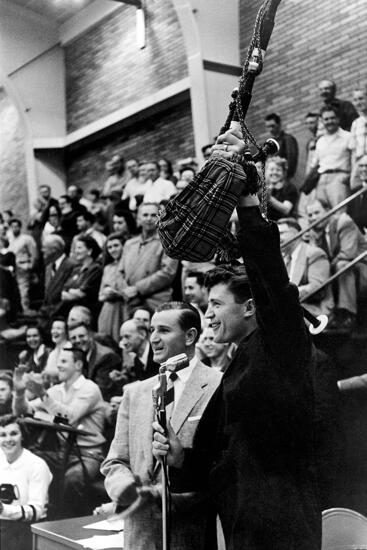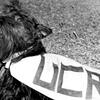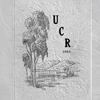‘A large, fine, famous, school’
Seventy years ago, Riverside’s UC campus opened to students
By John Warren
U C Riverside’s beginnings as a University of California campus trace back to 1906, when Riverside was named the site of the Citrus Experiment Station that would serve Southern California’s Citrus Belt. But 2024 marks the 70th year of UCR as a four-year university.
Its 1954 incarnation was far different from the research university we know today. It was a tiny liberal arts college, with more than one faculty member for every two students. UCR’s first provost, former UCLA dean Gordon Watkins, recruited high-profile, gifted instructors at handsome university salaries, assuring them their focus would be teaching — not a lot of teaching, at that — and not publishing.
“So far-reaching and vigorous was our recruiting that, on many college campuses, we were characterized as a ‘band of bandits,’ and ‘loathsome, seductive creatures,’” Watkins later recalled.
The state spent $6.5 million to open the new campus. Ground was broken on July 30, 1952, and construction began on the first buildings, arranged around a campus quad meant to emulate those of the elite liberal arts colleges in the Northeast. Those buildings would be Webber Hall, Geology, Physical Education, Watkins Hall, and Life Sciences.

Excitement was predictably rampant in the Riverside community at UCR’s opening. On Feb. 15, 1954, the first day of classes, the local Riverside Daily Press published a special UCR supplement. An editorial in the supplement read: “UCR is destined to become a large, fine, famous school.”
There were 126 students, 11 of whom registered at the last minute. The first classes were at 8:30 a.m. Jim McMillin, a Navy reservist stationed at Camp Pendleton, had the distinction of being the first student admitted. McMillin was typical of the spring 1954 class — many of them were transfer students, in their 20s, and many were Korean War veterans.
“Classes are small enough to learn something in,” McMillin said. “The student receives more attention.”
In fact, there were 65 faculty for those 126 students.
“Never have so few been taught by so many,” quipped Watkins, who is said to have known every student by name.
There was torrential rain on the weekend preceding UCR’s opening. There weren’t yet concrete walkways throughout most of campus, and it was a mud bath. The Physical Education building flooded, including the locker rooms and a basement bookstore. A crate of books was damaged. Much mopping commenced.
Temporary walkways of packing box crates connected all the buildings. Administration appealed to the public to postpone campus visits until the sidewalks were completed. Conway Pierce, head of the physical sciences division, declared the festivities had invoked “the fifth law of thermodynamics — that it rains whenever a new college opens.”

Watkins spoke — in his distinct Welsh accent — at 11:30 a.m., replacing the normal schedule of classes. In Room 1000 of the Humanities Building, a large lecture hall seating 200, he said: “I am deeply gratified with the student enrollment this year and particularly with the distribution.” He commented further that he regretted the absence of a lawn (there also were no trees).
There were few campus amenities. A temporary cafeteria was being built in the Citrus Experiment Station’s former horse barn — what would later become the iconic Barn restaurant. Until then, campus had only the UCR Coffee Shop in the basement of the Physical Education building, serving sandwiches, coffee, malts, doughnuts, ice cream, milk, and cake or pie. Hamburgers and fries would come later. There was a mom-and-pop off-campus called the UCR Pantry, not affiliated with the university.
By fall 1954, there were 500 students registered for the first full academic year — short of the 800 for which Watkins had hoped. This was the first four-year cohort, to be called “The Pioneer Class.” On the first day of instruction, Sept. 20, 1954, reporter Tom Patterson of the Riverside Daily Press wrote: “The machinery seemed to be well-oiled, and the process went on with a minimum of confusion.”
Instead of one to three students in some classes, there were now a respectable 10 to 20. Still, fall 1954 freshmen Jean Baker Field would recall in a 1998 oral history: “I don’t know if there was another college in the nation that was as small as we were … it’s just mind boggling when I think back on how lucky we were to have such small classes.”
The student body was set on forming traditions, which student leaders said helped define sister campuses Berkeley and UCLA. Those traditions — many of which still help define UCR — included the student-built “C,” a giant concrete letter atop the Box Springs Mountains that overlook campus. The student body voted to adopt “Highlanders” as the campus mascot, inspired because UCR had the highest elevation of all the UC campuses. Various campus groups and buildings embraced the Scottish theme, considering it a sort of homage to the beloved Welsh provost, Watkins.
Another lasting UCR tradition from those first students is their own names, etched in concrete. Student Doug Mumma, inspired by the celebrity-signed sidewalks outside Grauman’s Chinese Theatre in LA, came up with the idea and borrowed a gravestone chisel so that his classmates’ names would have a lasting and uniform appearance. In a 2023 class reunion video, Mumma and classmates are seen tracing their names in the slabs, now inlaid in a walkway by the Highlander Union Building.
“There was nothing here that was established,” Mumma said. “So, we created everything here ourselves.”
(Photos courtesy of UCR Library, Special Collections and University Archives)
Here’s to the next 70 years of academic and research excellence.
With your gift to the UCR Fund, you power possibility at one of the nation’s leading universities for social mobility, educational access, and research excellence. Gifts made support the university’s greatest needs.
Give to the UCR Fund at donate.ucr.edu/fall2024.









